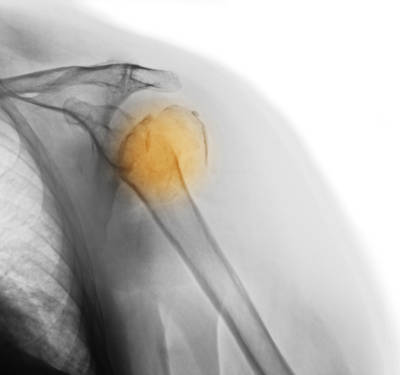Helping patients understand osteoporosis
Qataris with osteoporosis are better informed about their disease if they have a higher degree in education, says research.
Published online 29 February 2016

X-ray of the shoulder of an 81 year old woman with osteoporosis showing a fracture of the head of the humerus
© Scott Camazine / Alamy Stock Photo
Researchers surveyed 93 osteoporosis patients in Qatar about their perceptions of their disease. They found patients were more informed if they had a university or graduate-level degree. Also, patients obtained information about their condition from the media more often than they did from healthcare professionals. Based on their findings, the researchers suggest that television and radio should be targeted to raise awareness about the disease.
The study aimed to assess the general perceptions and knowledge of Qatari osteoporosis patients about their disease. “Self-management is very important in chronic diseases such as osteoporosis. It is unachievable if patients are uninformed about their condition,” says rheumatologist Mohammed Hammoudeh from Hamad Medical Corporation in Qatar.
A previous study reported a 12.3% prevalence of osteoporosis among postmenopausal women in the country.
In osteoporosis, bones become brittle owing to loss of bone density. This makes them more prone to fractures. The disease is more prevalent in postmenopausal and thin women. Smoking, alcohol and living a sedentary lifestyle are risk factors for the disease. Exercise and adequate amounts of calcium and vitamin D throughout one’s lifetime are important for prevention. Once diagnosed, patients need to take protective measures to avoid falls — such as wearing low-heeled shoes — and should avoid smoking and excessive alcohol intake.
A majority (92%) of the patients surveyed in the study were women. More than half had been diagnosed with osteoporosis five or more years earlier. More than 20% were illiterate and just under 30% had an elementary or intermediate education.
The team found that 31% of the patients were very well informed about osteoporosis, while 47% and 22% had good or moderate-to-low knowledge about the disease, respectively. Most were aware that osteoporosis was related to post-menopause, low bone density and an increased risk of fractures. Most were also able to identify smoking, low consumption of dairy products and low calcium intake as risk factors. Fewer participants were aware that thin women were more at risk for the disease than overweight women, while just over half the participants were aware that osteoporosis was preventable.
Although generally positive, the researchers say the results indicate that several aspects of patient knowledge and lifestyle could be improved. “Health professionals need to spend more time to educate patients with osteoporosis about their diseases, the importance of taking medication regularly, and how to prevent falls at home,” says Hammoudeh. They recommend that future research should study perceptions in larger samples of patients and in the general population. “This should aid in building and directing future modalities for the prevention and treatment of osteoporosis in Qatar,” Hammoudeh says.
Reference
- Hammoudeh, S., Abdelrahman, M. H., Chandra, P. & Hammoudeh, M. An assessment of patients' knowledge of osteoporosis in Qatar: a pilot study. Qatar Med. J.2015, 13 (2015). | article
DOI: 10.1038/qsh.2016.102

